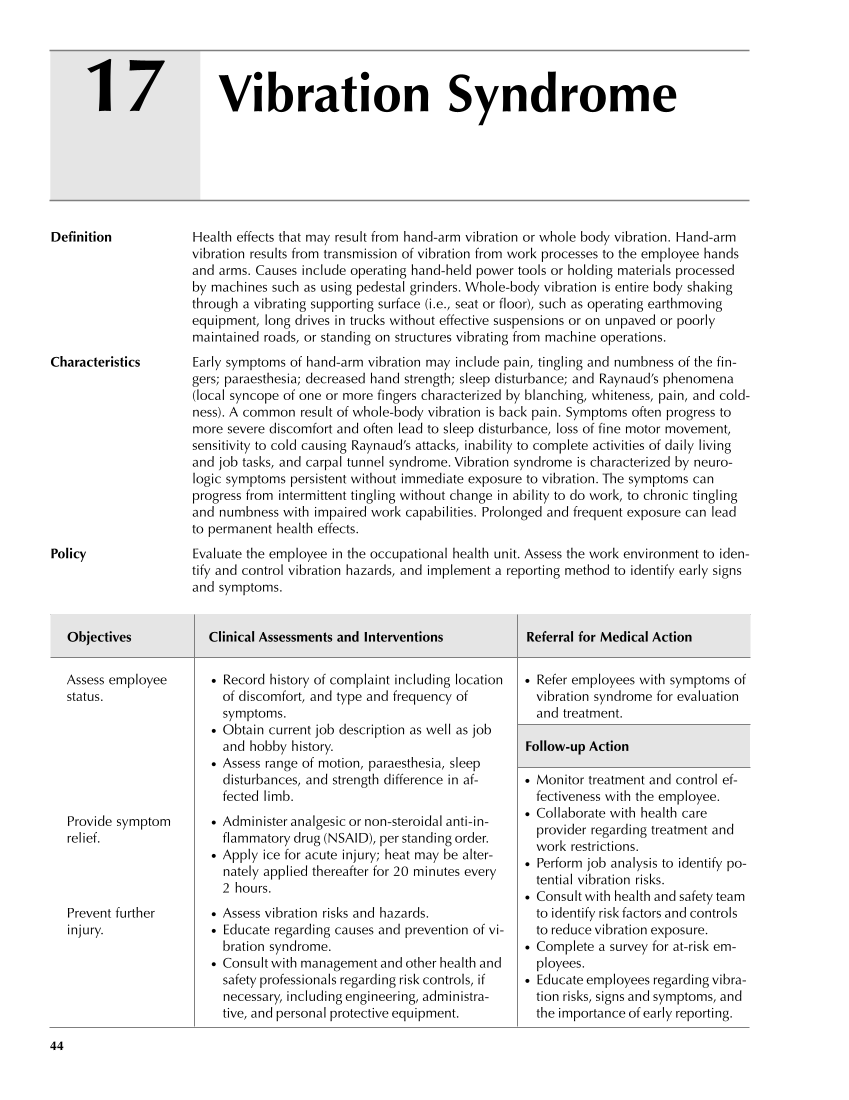17 44 Definition Health effects that may result from hand-arm vibration or whole body vibration. Hand-arm vibration results from transmission of vibration from work processes to the employee hands and arms. Causes include operating hand-held power tools or holding materials processed by machines such as using pedestal grinders. Whole-body vibration is entire body shaking through a vibrating supporting surface (i.e., seat or floor), such as operating earthmoving equipment, long drives in trucks without effective suspensions or on unpaved or poorly maintained roads, or standing on structures vibrating from machine operations. Characteristics Early symptoms of hand-arm vibration may include pain, tingling and numbness of the fin- gers paraesthesia decreased hand strength sleep disturbance and Raynaud’s phenomena (local syncope of one or more fingers characterized by blanching, whiteness, pain, and cold- ness). A common result of whole-body vibration is back pain. Symptoms often progress to more severe discomfort and often lead to sleep disturbance, loss of fine motor movement, sensitivity to cold causing Raynaud’s attacks, inability to complete activities of daily living and job tasks, and carpal tunnel syndrome. Vibration syndrome is characterized by neuro- logic symptoms persistent without immediate exposure to vibration. The symptoms can progress from intermittent tingling without change in ability to do work, to chronic tingling and numbness with impaired work capabilities. Prolonged and frequent exposure can lead to permanent health effects. Policy Evaluate the employee in the occupational health unit. Assess the work environment to iden- tify and control vibration hazards, and implement a reporting method to identify early signs and symptoms. Objectives Clinical Assessments and Interventions Referral for Medical Action Vibration Syndrome ● Refer employees with symptoms of vibration syndrome for evaluation and treatment. Follow-up Action ● Monitor treatment and control ef- fectiveness with the employee. ● Collaborate with health care provider regarding treatment and work restrictions. ● Perform job analysis to identify po- tential vibration risks. ● Consult with health and safety team to identify risk factors and controls to reduce vibration exposure. ● Complete a survey for at-risk em- ployees. ● Educate employees regarding vibra- tion risks, signs and symptoms, and the importance of early reporting. Assess employee status. Provide symptom relief. Prevent further injury. ● Record history of complaint including location of discomfort, and type and frequency of symptoms. ● Obtain current job description as well as job and hobby history. ● Assess range of motion, paraesthesia, sleep disturbances, and strength difference in af- fected limb. ● Administer analgesic or non-steroidal anti-in- flammatory drug (NSAID), per standing order. ● Apply ice for acute injury heat may be alter- nately applied thereafter for 20 minutes every 2 hours. ● Assess vibration risks and hazards. ● Educate regarding causes and prevention of vi- bration syndrome. ● Consult with management and other health and safety professionals regarding risk controls, if necessary, including engineering, administra- tive, and personal protective equipment. Guideline continues on next page
Purchased from OEM Press by (ge corporate access). (C) 2013 OEM Health Information, Inc. All rights reserved.












































































































































































































































































































































































































































